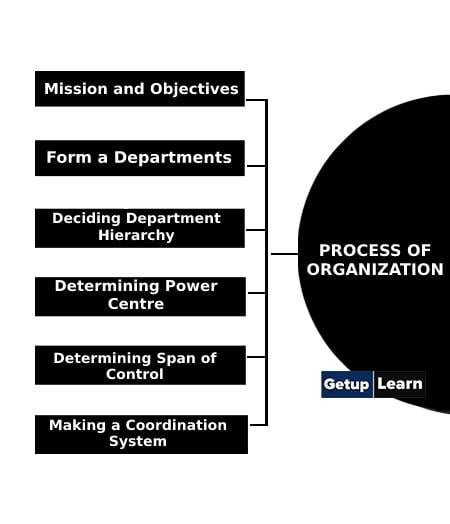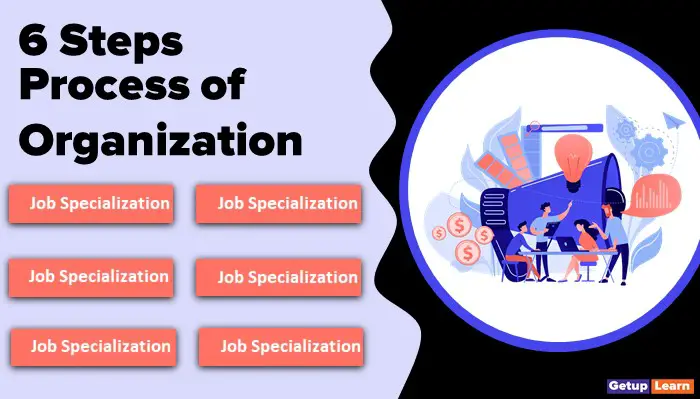Table of Contents
Process of Organization
In the process of organizing function, the manager usually divides the work into small jobs and then interlinks each one with the defined work. The process includes, on one hand, differentiation of activities (jobs) and on other hand, integration of all the activities to get work done.
These are the steps of the process of organization:
- Mission and Objectives
- Form a Departments
- Deciding Department Hierarchy
- Determining Power Centre
- Determining Span of Control
- Making a Coordination System

Mission and Objectives
Know the Organization’s Vision, Mission, and Objectives: The organizing process start with the vision of the organization. This means where the organization wants to be in the future. To realize this vision, defining the missions to achieve the vision is essential.
The mission actually gives way to the objectives. Once the objectives are clear then the further process becomes easy. These objectives in practice, give the type, and nature of activities needed to achieve those objectives.
Form a Departments
Identify the Activities and group them to form Departments: After knowing the objectives well, the next step is to identify the activities necessary to achieve them.
All the similar activities are then clubbed into one group called Department. This departmentation process is also necessary to determine the resources required for similar activities.
Deciding Department Hierarchy
The grouping of the activities is not sufficient to start the job rather the hierarchy of these departments is also equally important. Deciding which activity is prime activity and which one is secondary, is required in order to know the core departments and serving departments.
The key departments are directly linked to the objectives and hence gain a prime place among others. If prime activity is not formally decided, the management tends to dilute the efforts by focusing on minor activities.
For example, the academic institution must take teaching on priority as compared to any other issue. Advertising firms must have a core focus on advertising-related developments. It also tells about the core business organization is in.
Determining Power Centre
Once the hierarchy is established, the next step is to determine the power center, which means where the decision-making power lies. The major positions having authority to take decisions is important.
The key departments are given more authority as they are directly affecting the business of the organization. Full centralization can make a decision-making process slow and hence affect the efficiency of the system.
On other hand, decentralization may lead to losing control of the system and thus lead to the coordination process being ineffective. Therefore, it is important to decide the degree of decentralization in the system. This becomes a crucial strategic decision to be made.
Determining Span of Control
The span of control means how many persons will work under one supervisor/boss. In simple words, it is concerned with the number of persons one man can handle effectively at a time.
The wide span may lead to an ineffective system whereas a narrow span can make the structure taller leading to long communication channels and increased expenditure with an increased number of supervisors. Hence, it is important to decide the span of control strategically.
Making a Coordination System
The music cannot be melodious if every instrument is played without linking each other. The coordination is just like creating melodious music out of different instruments (department/activities).
For example, the production department has to tune its efficiency with the marketing department. If they do not, it will be a mismatch in demand and supply leading to a loss of business. Hence it is very important to set up a mechanism of coordination. The element of this mechanism should be imbibed into the structure.
What are the 6 steps of process of organizing?
Following are the 6 steps of process of organizing:
1. Mission and Objectives
2. Form a Departments
3. Deciding Department Hierarchy
4. Determining Power Centre
5. Determining Span of Control
6. Making a Coordination System.

